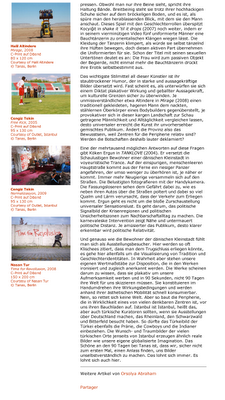
An exhibition about somewhere only we know
05.03.2010-31.05.2010
Frac Corse
La Citadelle 20250 Corte, Corsica/France
The island is what the sea surrounds and what we travel around. It is like an egg. An egg of the sea, it is round. It is as though the island had pushed its desert outside. What is deserted is the ocean around it.
Gilles Deleuze
The country is first of all the space of a land considered from a certain corner or angle, a corner delimited by some natural or cultural feature (as one says when one thinks one can tell the difference): a row of trees or a road, a river or a ridge, a pass, a glacial constriction, a formation of alluvial deposits, a passing herd or an armed horde, an encampment.
Jean-Luc Nancy
"Fantasy & Island" is triggered by an institutional dialogue between Istanbul and Corsica on the occasion of the Cultural Season of Turkey in France. Initiated by a collective curatorial approach, the project is designed as a process-based exhibition, which approaches selected contemporary forms of artistic organization such as "residency", "collection" and "exhibition", asking how they manifest on a Mediterranean island. Conceptually, the exhibition departs from the reality of its location and the physicality of being based on an island as a psychological, social, cultural, literal and metaphorical level of discussion, bringing a selection of works that reflects the diverse dimensions of the island as a "ground for image." Referring to Jean-Luc Nancy's recent work, "The Ground of the Image", which focuses on the split between image, imagination and the uncanny landscape, this exhibition project aims to transform its venue, Frac Corse, into an experience of an island as a conceptual entity.
The artist residencies in Istanbul and Corsica have operated as pilot studies for an intercultural dialogue; four artists have bridged these two different contexts through their body of work and their approach of study. As a resident artist in Istanbul, Gael Peltier's performative work investigates the borders of stage and stage-personality through different narrative forms. His focus within the context of this exhibition brings an insider-outsider's gaze onto a transparent dialogue with the audience. Hakima el Djoudi, on the other hand, creates a monument as a critical form of political representation linking militarist regimes with economical structures , specifically developing a new version - with Turkish Liras - for this show. Istanbul-based painter Leyla Gediz's two drawings and one painting -products of her residency in Ajaccio- compose an installation that narrates a triangle for a happily ever-after story: a personal attachment with a kid-size shoe, a flashback memory of an interior landscape from the island and a conceptual joke with a found object. Another resident artist from Turkey in Ajaccio, Can Altay, reconstructs social forms of life in order to develop conceptual relationships between the architectural and structural elements of mobility and communication and translates them into specific forms of imaginary island(s) that float(s) on the ground of the space.
Several art works from the collection of Frac Corse have also been incorporated into the curatorial structure of the exhibition, such as Şener Özmen & Cengiz Tekin's "Bonjour Monsieur Courbet", a collaborative video work as parody of an art historical representation, Liam Gillick's "Discussion Island Platform", an abstracted form of a critical discourse about discussion platforms, Gabriel Orozco's image of a parachute landing on Iceland, and Dan Graham's sculpture that crystallizes the constant dialogue between inner and outer spheres as conceptual abstraction.
Is an island a piece of land that is surrounded by water or is it surrounded by itself as reflection of its epistemological/ontological entity? Is it reflected on itself or is it reflexive itself?
In order to respond to these questions through the first-hand experience derived from a life on an island as an inhabitant, witness or storyteller, other artists have also been asked to contribute to the exhibition process. Christodoulos Panayiotou displays a selection of images from the historical archives of Limassol, Cyprus from Disney Parades in the 70's. As an outcome of Aslı Çavuşoğlu's collaboration with a Turkish rapper, the audience is confronted by an installation of official documents, LPs, and a sound system that plays the song titled "191/205" -written with 191 (including "revolution", "equal", "whole") of in total 205 words that were censored by the national TV channel, TRT (Turkish National TV & Radio) -right after the coup d'état in Turkey in 1980. The young Corsican artist Verana Costa's video work is a resistance against constraint: in the video the repetition of interrupted breathing creates a sensation of oppression as well as a concentrated energy, whereas David Raffini's paintings can be considered as artistic expressions that redefine the psychological territory of his presence on the island. Ajaccio-based artist Elie Cristiani reverses the perspective of a passerby -upside down - and ironically frames how everyday life is publicly circulated on an island.
Bringing together a selection of art works, which are produced on islands such as Corsica, Iceland and Cyprus, or related to contexts such as Diyarbakır or Istanbul - both sites that readily associate with the island metaphor - "Fantasy & Island" deals with the physical conditions of living on an island. The exhibition attempts to present forms of isolation, mobility and attachment that decode the physicality of an island, as well as engaging with political and cultural connotations of closed systems resulting from ideological control and repressive regulation -such as censorship, the coup government in Turkey in the 80's or 70's and an isolated Cyprus under global attacks.
Ending up on an island brings endless possibilities that could happen at the same time with an unbalanced form of co-existence: joy and tension, imprisonment and emancipation, isolation and intimacy, farewell and arrival... As a ground for the images of today's islanders, "Fantasy &Island" is an exhibition about the territorial power and limits of control, about what surrounds us and what we are surrounded with - and somewhere only we know...
Curated by Anne Alessandri, Celenk Bafra and Adnan Yildiz














